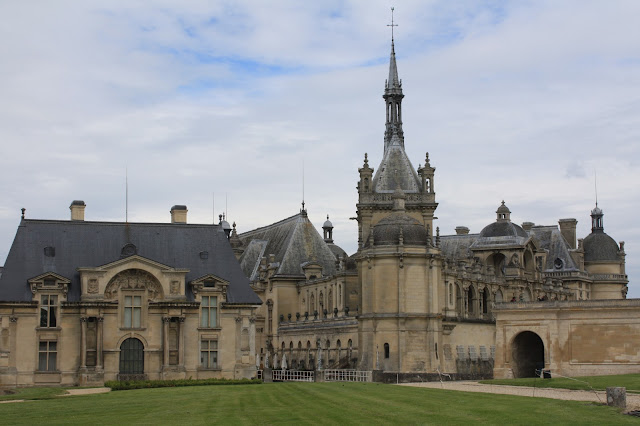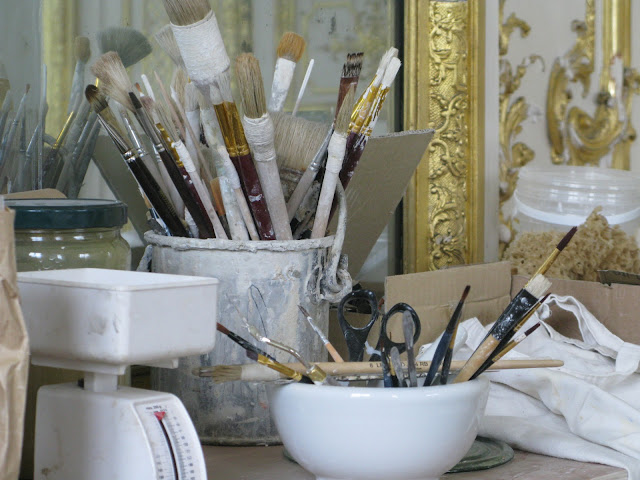Even though that is where Chantilly creme -- whipped cream -- was supposedly invented.
But our wonderful friend Francoise, no doubt with help from Suzy, made arrangements for us. While we were in Paris, their friend Claudine was planning a visit to the Chateau with her friend Claudette. (Neither of these charming French ladies was to be confused with our Alliance Francaise instructor here, Claudia, but we managed to confuse them anyway.) So even though we had never met Claudine or Claudette, they made plans to pick us up outside our apartment building on Rue Lepic, and drive us to the Chateau. While there, Claudine pointed out many of the must-see features, and told a few stories associated with its past.
The original mansion was built in the 15th Century, but became more closely what it is today in the 16th Century. During the revolution it was reportedly reduced to rubble, but redesigned and rebuilt in the mid 19th Century. Ultimately it was donated to the French government at the end of the 19th Century.
Claudette, Claudine and Tom trudge up the road to the entrance of the Chateau.
Across the road from the Chateau is the old stables, used back in the day for the 100 horses kept on the grounds. It has been replaced by a new stables, across the road from the entrance, which are considered one of the finest in the world.
I'm guessing hunting was a favorite pastime, and the duc d'Aumale who renovated it, memorialized some of his pals at the gate.
The Chateau is as famous for its elaborate water works and canals, and sits at an odd angle with water on two sides.
The view from the drawbridge into the Chateau gate.
The Chateau houses the Conde Museum, the finest museum of paintings in France after the Louvre. When the Chateau was given to the state, one condition was that its works never be sold or lent. So if you want to see the stunning collection of Ingres, Delacrois, Lippi, Watteau, Poussin, Van Dyke and others, you will have to see them there. Some of the paintings are so well-known that it is startling to turn around and see a portrait of Napoleon or Louis XVI or Marie Antoinette in such a surrounding.
There was a variety of objects as well, from fans and watches to precious jewels. The most famous, having been stolen once and found only by chance, is now locked away, with a fake in its place.
One gallery was a showplace for leaded windows telling the story of
Tom read the whole thing -- the story of Psyche.
The window gallery was also graced by a bust of a former owner in wax, an unusual medium
.
This is a cabinet inlaid and topped with geological specimens, presented to the duc by the King of Sweden, with whom he shared an interest in science.
We were lucky to visit the library, which had undergone recent renovations. Note the chair on the balcony, and the reading chairs with desks attached at one end.
Decorating tip: Nothing makes your guests feel at home as much as a small canon by the fireplace!
As we made our way to the gallery, we passed through a room being renovated.
The gallery, a mini-version of Versaille'sHall of Mirrors.
Our merry band...Claudette, Claudine and Tom.
The nearby Monkey Room; look closely!
The place is guarded by a very large dog!
The Chateau is as famous for its gardens as for the Chateau itself. The gardens are far less extensive than they once were, since much of the grounds were taken in the revolution for the site of the nearby town. What had been gardens as extensive as Versailles, but with more elaborate water works and canals, are now much less so. But even so, we did not have time in our day's visit, to explore them.
The gardens and water works were designed by Andre Le Notre, who was later drafted by Louis XIV to design the gardens and water works at Versailles. Our visit to the Chateau included a stop in a nearby building to see an exhibit about La Notre's design and how it changed over the centuries. We learned that the waterworks had been allowed to fall into ruin, and when the Chateau was taken over by the government, it took decades to discover where the hidden mechanisms were and how they worked, and then to rebuild them.
As an interesting side note to our visit to Russia, Peter the Great had been very impressed by Le Notre's waterworks at Versailles, but he was dismissive of the lack of water pressure there. The water pressure was so low that the fountains and water features only flowed when the king was passing by. When Peter began work on his summer palace, he commanded that there be sufficient water pressure to run the fountains continuously, which required more careful engineering. Of course, his palace was by a river near the sea, whereas Versailles is near Paris, with only a king-commanded canal as a water source.
A view from inside the Chateau.
We left the Chateau after a very full morning, and headed into the gardens in search of lunch.
This looked promising...
but once inside the courtyard we found an odd Indian buffet that did not appeal, so out we went.
We retraced our steps and took another path, which led us to our destination, the Hameau.
No wonder we had been lost -- we were victims of poor signage!
The Hameau (hamlet) was a faux village (see the waterwheel!) used by the owners to entertain their guests in sumptuous but casual fashion. Peter the Great of Russia was delighted to visit, and several other royal guests wrote about their delightful meals there. Of course it was all just as elegant as dining in the Chateau, but the setting gave visitors the illusion they were roughing it.
Tom, Claudette and Claudine ready to order lunch in the tent in the Hameau. The Chateau once included an extensive dairy herd, which I think is still there, if in reduced size. Rumor has it that Chantilly cream -- whipped cream -- was invented there. I know I had a terrific salade gesiers (green salade with hot chicken gizzards -- always an excellent choice!), but I will never forget the dessert -- raspberry and blackberry sorbets with, naturellement, creme Chantilly.
Rumor also has it that creme Chantilly is whipped cream. Don't believe it. This cream was richer, denser and probably had more fat than whipped cream. Recipes I've looked at say it is nothing more than heavy cream, sugar and vanilla. I don't think so -- there is something else going on here. I guess I will just have to return to figure it out!
Lunch was over, and time to make our way back to the Chateau.
This time we did not go in, but around the outside, taking in the gardens and ponds closets to the Chateau, on our way to the Le Notre exhibit.
Can't miss the wildlife!
Above you can see in the ditance the entrance to the world famous stables. We stopped instead at the Le Notre exhibit, with its entrance between the two topiary pots.
The exhibit was in the building above; the grand arch to the stables is below.
A last look a the stables as we headed toward the parking lot and Claudine's car....
...and a longer look at the Chateau.
















































































































